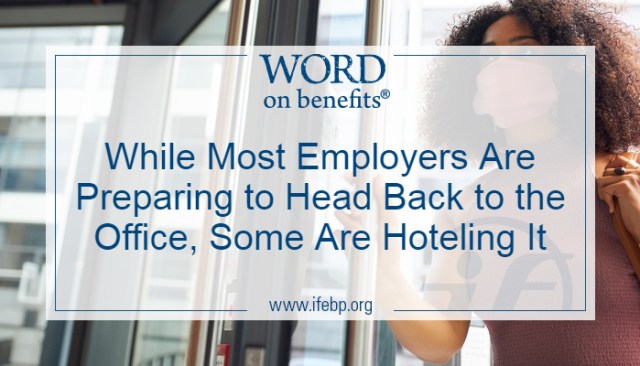
A new report released today by the International Foundation, Employee Benefits in a COVID-19 World—One Year Update, provides a snapshot of the latest COVID-19 workplace issues including the future of remote work and vaccines.

How Are Employers Handling the COVID-19 Vaccine?
The majority of employers (63%) are strongly encouraging vaccination, but few employers, just 4%, are mandating that workers be vaccinated. Fourteen percent of employers are providing incentives to encourage worker vaccination.
Employers are verifying worker vaccination in a variety of ways, including:
- Asking workers to show proof (i.e., documentation) of vaccination: 15%
- Asking workers to verify vaccination but not asking to see documentation: 11%
- Mandating proof/documentation of vaccination: 5%.
[Related Reading: Employers Offering COVID-19 Vaccine Incentives Including Paid Time Off, Cash, and More]
Who Will Return to the Office, and What Can They Expect?
Employers report that, on average, 55% of their workforce is currently working remotely. When asked to look ahead to April 2022, employers anticipate that roughly 32% of their workforce will be remote. Prior to the pandemic, employers reported that 12% of their workforce worked remotely.
When employees do go back to the workplace, many will be returning to an office that looks different from the one they left. Changes employers are making to the physical workspace include:
- Implementing hoteling for some or all workers: 18%
- Downsizing the physical workspace: 17%
- Making other changes such as adding plexiglass barriers and air purifiers, enhancing cleaning protocols or limiting the number of people in the building: 13%.
Nine percent of employers report they are eliminating the physical workspace altogether.
What Other Changes Are Organizations Making?
Increased Access to Mental Health Benefits
Due to the pandemic, 23% of employers added telepsychiatry as an employee benefit, and 9% are considering adding it. Of those that added telepsychiatry, almost all have made it a permanent change (71%) or are considering making it a permanent change (26%).
Additionally, the pandemic caused 16% of employers to add services to their mental health benefits, while 21% are considering adding services. Of those employers, 82% say it’s a permanent change.
Flexibility for Caregiving
Many employers have implemented more flexible hours for caregiving needs. For some workplaces, these changes will be permanent. Nearly half (45%) of employers have implemented flexible hours to accommodate child-care needs during the pandemic and, of those who have made this change, 28% report that it is a permanent change, and 47% are considering making it permanent.
During the pandemic, 33% of employers have implemented flexible hours for elder-care needs. Of those who have made this change, 35% report that it is a permanent change, and 42% are considering making it permanent.
Changes in Vacation/Paid-Time-Off Policies
The pandemic also caused many employers to make changes to their carryover options for vacation days or paid time off, allowing employees more options for their unused time off. In the last year, 17% of employers have implemented more carryover options for paid leave. Almost a quarter of those employers (24%) plan to make this a permanent change, while 17% are considering making it permanent.
“The pandemic has presented a unique opportunity for employers to examine their benefit offerings and overall culture and to make changes that they may not have made otherwise. It has accelerated trends that were already in motion, brought to the forefront new ideas and priorities, and given organizations an opportunity to evaluate what works best for their workforce.”
Julie Stich, CEBS, vice president of content at the International Foundation of Employee Benefit Plans
Learn More About COVID-19 and the Workplace
Employee Benefits in a COVID-19 World—One Year Update was conducted in May 2021 and is the third installment in a series examining the implications of COVID-19 on health care benefits, paid leave and flexibility as well as return-to-office considerations, including physical workplace changes and worker vaccinations. International Foundation members can download the full report here.
Plan sponsors can visit our Coronavirus (COVID-19) Resources webpage for more information and the latest guidance.
Brenda Hofmann
Communications Manager at the International Foundation

The latest from Word on Benefits:
- Mental Health Parity: What Plan Sponsors Need to Know During Period of Nonenforcement of 2024 Final Rule
- CMS Creditable Coverage Updates for Group Health Plans
- The New Look of Virtual Care: What’s Right for Employers and Plan Sponsors?
- Ontario’s New Long-Term Illness Leave Takes Effect Soon: What Employers Need to Know
- What Benefits Are Working? Attracting and Retaining Employees





